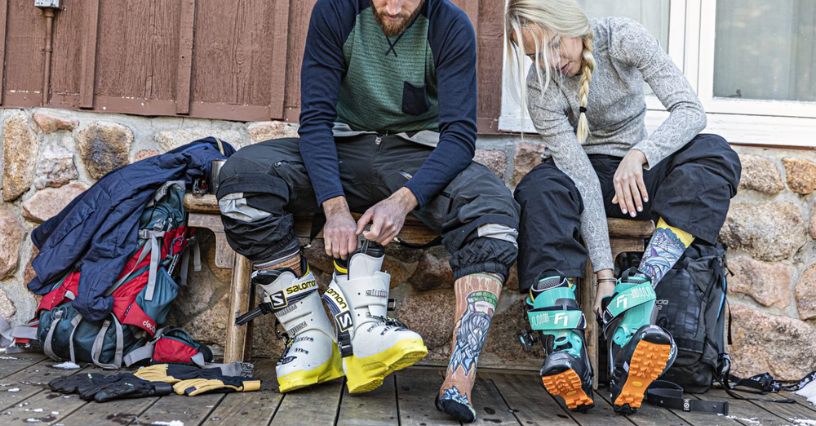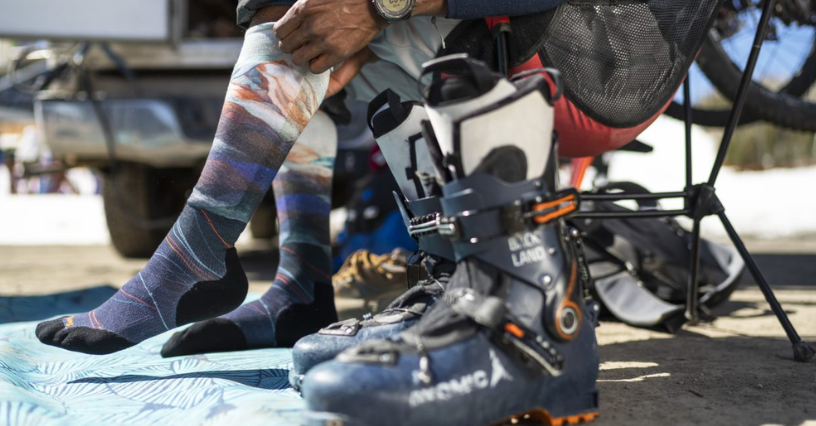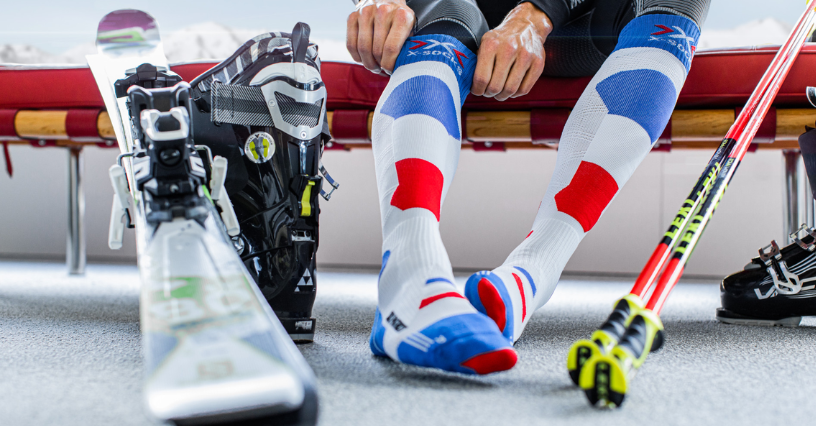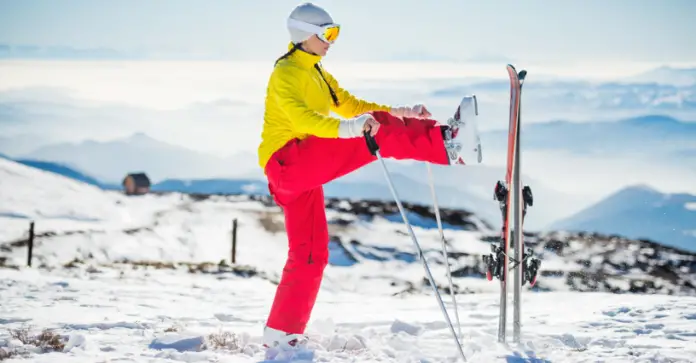Socks are usually the last thing we focus on when completing a ski or snowboard outfit. However, the extent to which we take care of our feet will have an impact on our skiing performance and the level of satisfaction of a day on the slopes.
In this article, we suggest which ski socks to choose to keep your feet warm and dry, regardless of the intensity of the race and the weather conditions.
Ski socks – why you should have them?
Unlike classic cotton socks or trekking socks, ski socks have a design that allows them to adapt to the shape of the foot. Thanks to their ergonomic shape and the presence of elastomers (plastic or natural materials that, due to mechanical forces, can deform without changing their structure – the process is reversible), they do not twist or slide when you move, allowing you so you can enjoy a comfortable journey.
These types of socks are also equipped with padding placed in key areas such as the shins and have a seamless construction, which not only influences the efficiency of the effort, but also increases the durability of the socks.
Padding on the shins also provides extra cushioning to reduce the risk of bruising, while padding around the toes provides extra warmth and relieves pressure from the footwear.
Heel reinforcements and contoured areas mold to the foot and keep the sock in place, preventing accidental slippage or rubbing that could irritate the skin.
Ski and snowboard socks use materials that wick moisture (polyester, nylon, lycra, acrylic or merino wool) away from the skin to keep your feet dry and reduce the risk of your toes getting cold or numb.
Is it necessary to wear two pairs of ski or snowboard socks?
In extremely cold weather, we are often tempted to take off and put on an extra pair of warm woolen ski socks.
Why shouldn’t you do this? Very thick socks take up a lot of space in the shoes, and this can cause pain, pressure and impede blood circulation.
The outcome? Your feet will get cold instead of warm. Additionally, socks worn on top of each other will rub against each other and can therefore cause skin irritation and blisters.
Medium or thin moisture wicking socks made from merino wool ensure your feet stay dry and well insulated with plenty of room for your toes.

Which ski socks to choose?
Well-fitting ski socks will not interfere with the adjustment of your ski or snowboard boots. This should end below the knee to not put pressure on the calf and to provide extra warmth for the lower leg. It should also be adapted to the intensity of the activity and the degree of sweating that your feet have. All of these aspects will affect the weight and construction of the ski sock you need.
It’s also worth matching this article of clothing according to gender, as women’s ski socks have wider cuffs to better fit a woman’s calf and are slightly shorter than men’s models. Kids ski socks are also built to give young skiers maximum warmth and comfort on the slopes.
Material
The most popular materials used in ski and snowboard socks are:
- synthetic materials – including: polyester, nylon, acrylic, lycra, polyamide and elastane. Due to their use in different proportions, they retain their shape for a long time, even during frequent use. They are distinguished by their excellent absorption properties. In addition, polyester is soft to the touch, nylon is characterized by its high durability, which is why it is often used to reinforce those parts of the sock that wear out the fastest (mainly the shins and heels), while acrylic is not prone to wrinkling or clumping. Elastane and lycra, on the other hand, due to their elasticity, are usually used for an optimal fit on the leg and calf;
- merino wool – sourced from New Zealand sheep, the wool is extremely soft, warm and highly breathable. It wicks away moisture very well and thanks to its antimicrobial properties, it does not accumulate odors as easily as synthetic materials. This means you can wear a pair of merino wool ski or snowboard socks longer between washes. Read more in our guide to merino wool .
- wool – excellent moisture wicking, heat retention, durable and comfortable to wear, but less shape retention than synthetics – warps easily.

Thickness
Thin and light, these socks are perfect for skiers and snowboarders who want increased control and feel of their gear. They are also a good solution for warmer days. Mid-weight and thick ski and snowboard socks are a versatile choice that balance comfort, warmth and performance. The thickest socks available, on the other hand, are ideal for beginners or recreational skiers and snowboarders or people who get frostbite.
Size
Ski socks come in standard sizes, but before you buy a particular pair, check the manufacturer’s size charts and match the model to your foot length. A sock that’s too small will fit tightly around the calf, causing painful pressure points, limiting toe movement and causing general discomfort, while a sock that’s too big will roll up and encourage blisters.
Seams and reinforcements
Most ski socks have flat seams, which are extremely smooth to the touch and do not irritate the skin, or have seamless construction. All types of reinforcements and joints of a ski or snowboard sock increase the comfort and performance of movement by absorbing shocks, for example.
Most common is arch support in the form of a thicker, tighter or flexible piece of material (eg rubber) which helps maintain the natural alignment of the foot and reduces the risk of excessive foot fatigue or uncomfortable positioning in the shoe , which may cause injury. Support is also used in the ankle, Achilles heel and shin area.
In turn, the reinforcements in the heel and toe area increase the durability and resistance of the socks to abrasion or tearing. In the upper leg area, the socks can also have multi-zone mesh panels to improve air circulation while reducing pressure points.
Why you shouldn’t use cotton socks for skiing or snowboarding?
The disadvantage of cotton is that after wetting it takes a very long time to dry and in addition, it becomes heavy. Meanwhile, even at very low temperatures, the feet sweat relatively quickly. If this moisture stays close to the skin, the feet will be cold even with the best insulation used in ski boots. So, wearing cotton socks for skiing or snowboarding puts you at risk of discomfort and cold.
Compression ski socks – for whom?
Compression socks help increase blood flow to the feet, and as mentioned earlier, proper circulation and adequate blood flow are essential to keeping feet warm while walking. Compression socks for skiing and snowboarding will work well for those with poor circulation or who are prone to cold feet. They’re also a good option if you’re facing a long, intense workout.




